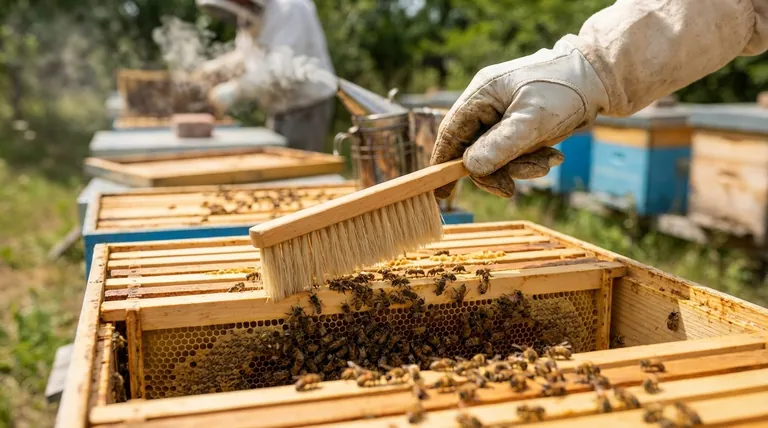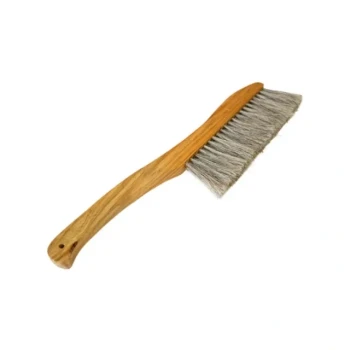On the contrary, a bee brush is a tool designed specifically to protect bees from harm. Its sole purpose is to gently move bees away from areas where a beekeeper needs to work, such as the edge of a hive box or a frame of honey, ensuring the bees are not crushed or injured during inspections.
The central challenge for any beekeeper is interacting with the hive while causing minimal stress and harm to the colony. A bee brush is the primary tool for gentle, small-scale persuasion, but understanding its limitations is key to responsible hive management.

What a Bee Brush Is and How It Works
A bee brush is one of the most basic and essential tools in beekeeping. Its design and intended use are centered entirely on the safe and gentle handling of bees.
The Purpose: Gentle Encouragement
The goal is never to force bees, but to gently encourage them to move. During a hive inspection or honey harvest, bees can congregate on the tops of frames or the edges of hive boxes. A brush allows the beekeeper to carefully usher them back down into the hive, preventing them from being squashed when a lid or box is replaced.
The Design: Soft Bristles for Safety
A proper bee brush features long, soft, and flexible bristles. These are typically made from natural hair or very soft synthetic fibers. This construction ensures that when the brush makes contact with a bee, it coaxes the bee to walk away rather than injuring its delicate wings, legs, or body.
Proper Technique: The Key to Calmness
Effective use of a bee brush requires a calm and deliberate hand. The beekeeper should use slow, sweeping motions to gently "paint" the bees off a surface. Aggressive or rapid brushing will only agitate the bees and can cause the very harm the tool is meant to prevent.
Comparing Methods for Moving Bees
While a brush is a fundamental tool, it's not the only method for moving bees. Different situations call for different techniques, each with its own impact on the colony.
The Bee Brush: For Precision Work
The brush is ideal for moving a small number of bees from a specific spot. It offers precision when you only need to clear a small area, like the ear of a frame you need to grip.
The Bee Vacuum: For Large-Scale Removals
For removing entire colonies from structures or capturing swarms, a specialized bee vacuum is sometimes used. Unlike a household vacuum, these are designed with very low, controllable suction and proper ventilation to pull bees into a containment box without killing them.
Shaking and Bumping: A Common Alternative
Often, the quickest way to clear a frame of most bees is a sharp shake or bump. A firm, downward shake directly over the hive will dislodge the majority of bees, causing them to fall safely back among their sisters. A brush is then used to remove the few that remain.
Understanding the Trade-offs
Choosing the right tool requires understanding the potential downsides of each method. The primary goal is always to minimize stress and harm to the colony.
The Risk of Agitation with a Brush
While gentle, brushing can still be perceived as an annoyance by the bees. Over-brushing or using a brush with stiff, cheap bristles can make the bees defensive. It is a tool for finesse, not for clearing hundreds of bees at once.
The Danger of Improper Vacuum Use
A bee vacuum is the riskiest tool if used incorrectly. Too much suction can physically tear bees apart, while poor ventilation in the capture box can cause them to overheat and die quickly. It is a tool for experienced specialists, not routine inspections.
When Shaking is Better Than Brushing
If a frame is covered in bees, a single, quick shake is often less disruptive than brushing every single bee off individually. Prolonged brushing can be more irritating to the colony as a whole than one swift action.
Making the Right Choice for Your Goal
Your approach should always be dictated by your specific goal and a commitment to the well-being of your bees.
- If your primary focus is a routine inspection: Use a smoker to calm the bees and a brush to gently clear small areas for grip and visibility.
- If your primary focus is harvesting honey: Use a firm shake to clear most bees from a frame, followed by a brush to gently remove any that remain.
- If your primary focus is removing a large swarm or cutout: Consider a bee vacuum only if you are experienced, as improper use poses a significant risk of harm to the bees.
Ultimately, effective beekeeping is about using the right tool with the right technique to work in partnership with your bees.
Summary Table:
| Method | Best For | Impact on Bees |
|---|---|---|
| Bee Brush | Gently moving small numbers of bees; precision work | Low impact when used correctly with soft bristles |
| Shaking/Bumping | Quickly clearing a frame of most bees | Low impact; a quick action is less disruptive than prolonged brushing |
| Bee Vacuum | Large-scale removals (swarms, cutouts) | High risk of harm if used incorrectly by inexperienced beekeepers |
Ensure the safety and health of your commercial apiary with the right tools from HONESTBEE.
We supply high-quality, gentle bee brushes and other essential beekeeping equipment designed for the rigorous demands of commercial operations and distributors. Our wholesale-focused approach ensures you get durable, effective tools that protect your valuable bees and streamline your workflow.
Contact HONESTBEE today to discuss your wholesale supply needs and equip your operation for success.
Visual Guide

Related Products
- Wooden Bee Brush with Triple Row Artificial Fiber for Beekeeping
- Wooden Bee Brush with Double-Row Horsehair Bristles
- Classic Wooden Bee Brush with Double-Row Boar Bristles
- Double Row Artificial Fiber Bee Brush for Beekeeping
- Premium Triple-Row Horsehair Bee Brush
People Also Ask
- What is a bee brush and how is it used in beekeeping? A Guide to Gentle Bee Handling
- What is the purpose of a bee brush? Gently Manage Your Hive with Precision
- What are the characteristics of the bristles on a bee brush? Designed for Gentle Persuasion, Not Force
- What is the purpose of a bee brush? Master Gentle Hive Management for Healthier Bees
- What are the key features of a popular bee brush? Essential Design for Bee Safety and Hive Hygiene



















